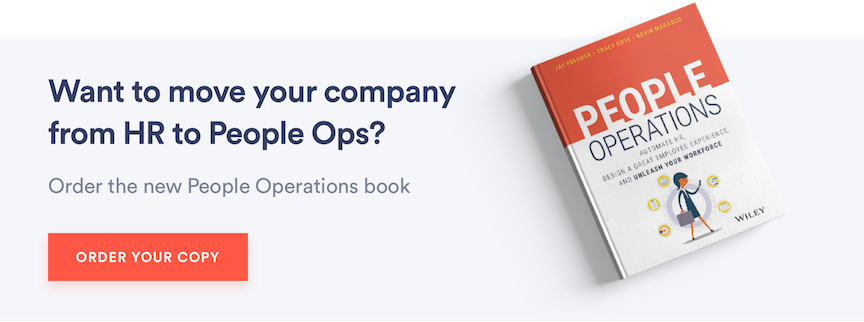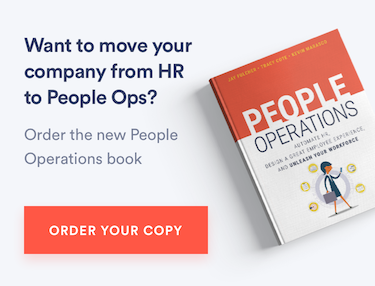
Subscribe on:
Q&A: Why does cybersecurity matter for today’s HR professionals?
Only a decade ago, HR teams had to be careful of leaving sensitive employee information on a copy or fax machine. Technology has changed drastically since then, making cybersecurity a much more real issue. Lourdes Rivera, Senior Director of People at Electric, shares why cybersecurity matters for HR professionals. Additional Resources: Order your copy of […]
Only a decade ago, HR teams had to be careful of leaving sensitive employee information on a copy or fax machine. Technology has changed drastically since then, making cybersecurity a much more real issue.
Lourdes Rivera, Senior Director of People at Electric, shares why cybersecurity matters for HR professionals.
Additional Resources:
- Order your copy of our book People Operations: Zenefits.com/pops-book

On this episode, you’ll hear:
- [00:27] How technology has changed
- [01:32] What the pandemic did to security
- [03:01] IT needs are evolving quickly
- [04:05] Where there are challenges
- [04:50] Ways to protect your people and business
- [06:45] How Electric could help
Transcript
Welcome to pops, the show that shows you how to shift from human resources, paperwork to people, operations for the new world of work. How by answering one question at a time. I’m Lourdes Rivera, Senior Director of People at Electric here to help answer the question, why does cyber security matter for today’s HR professionals? In the last 20 years, our ways of working have changed. In the early two thousands, offices were filled with desktop computers, fax machines, filing cabinets, and other large equipment that most Gen Z workers have likely never seen or used before. During those years, HR professionals were concerned with confidential employee information being left at a fax machine or someone accessing employee files left on someone’s desk or even in an unlocked drawer.
No employee wants their employment details or personal benefit information accessible by just anyone in the company. While IT professionals were concerned with employees walking away from their desk, leaving an unlocked computer access. This puts companies at risk of confidential company information or systems being accessed by a non-authorized user Over the last few years, flexible working has been such a huge rise in popularity since the Covid pandemic.
Most of the workforce had to find a way to work from. This required companies to make large investments in technology that would enable their employees to better communicate, collaborate, and operate regardless of where they work. The workforce needed to have remote devices deployed and shipped to them, which includes all current employees and future new hires or remote devices shipped or scheduled to be picked up by a mail carrier to return to their employers when offboarding.
And an internet connection and a secure cloud-based environment set up to collaborate and manage their work. While these initiatives are typically done in an effort to increase productivity and maximize flexibility, we often see that it also creates additional complexities when managing it at scale and protecting your organization’s data networks and applic.
Most organizations find that their IT needs are evolving quicker than their IT function can keep up with. If an organization is unable to live to deliver world class IT services across its distributed workforce, then there will likely be a significant disruption in remote productivity, which will likely be exacerbated as head count and time zones grow as.
The way organizations choose to support and manage their IT infrastructure in a distributed work environment will have major implications on their businesses going forward with that. Most of the existing options in the IT marketplace today have quite a few limitations. The most common way we see companies handling it today are the defacto environment where someone internally manages it, but it’s not their job, nor is it scale.
For example, have you or your HR team ever received an employee’s request to reset their work email password? Or has a new hire reached out for support with how to use Slack or access their department’s share drive? An alternative option is outsourcing to a traditional managed service provider, also known as an MSP that also struggles to keep up with more modern workforce.
It needs. These providers generally take hours to respond and charge by the hour for their service. And lastly, the most pertinent to larger companies is building out an internal IT team, which can be very costly. What we found is that all three options present major obstacles and typically lead to challenges such as slow resolution time, leading to a poor user experience, lack of security across multiple levels, limited visibility into inventory and software, manual on and off-boarding processes, and so.
Some of the areas where our HR and IT teams have experienced the challenges of supporting a hybrid workforce are disparate systems and processes. There are many, many SaaS applications being used by our workforce with various login requirements and lack of integration. There are long wait times for support from it leading to productivity delays and challenges, and most importantly, security risks to the.
So during this monumental shift to remote work and more distributed workforces, how do HR professionals protect their teams from growing cyber security threats? Here are six ways you can get started on protecting your people and your business. First, establish a cyber security culture. Make cyber security a priority and regular part of discussions and meetings treated as a normal, yet integral part of business operations.
Second, conduct the regular cyber risk assessment. Consider an annual at minimum review of your cyber risk. This includes updating policies as needed, evaluating software, reviewing risks, and so much more. Third Institute workplace policies. Build a structured set of rules for employees to follow. Include the cyber policies and procedures as part of orientation and inform employees of updates on a regular basis.
Make sure employees know what is expected of them and when it comes to cybersecurity. Fourth, create strong password policies and requirements ongoing. Word management can help prevent unauthorized attackers from compromising your agency’s protected information. Provide security training, offer and mandate if at all possible, depending on what state your workforce is in cyber training that will educate employees on cyber threats.
And how does stay safe? Employees are your first line of protection. And lastly, create an incident response. In case of an emergency, know what will be done in case of a data breach or other cyber incident. Create a clear set of responsibilities and who needs to carry them. When you’re hiring and managing talent, you need to make a positive impression at every step of the way.
Not to mention, you also need to be ready to execute on your security and compliance policy. Electric keeps these critical people processes moving quickly from pushing security updates to your team’s devices, to setting up MFA on your employees email accounts. Electric works with you to maintain security on the device, application and network.
Here are just a few ways. Electric saves HR teams time and money streamlined. Onboarding, offboarding, and access management means that everyone on your team will have access exactly to what they need for every people management scenario, device procurement, and provisioning. So your team gets their devices provisioned and delivered directly to them wherever they.
Standardized security across devices, apps, and networks. With cyber crime accelerating and evolving, your company needs an airtight threat detection and management strategy. Electric covers your basis across your security strategy, program development. Implementation and management Electric can save HR teams up to 50% on it, spend and provides 105% return on investment according to Forester.
Visit electric.ai to learn more about our IT solution for people leaders. 📍
Do you have a question for us? Click the link in the show notes. Or if you’ve got other ideas and feedback about our show, send them to podcast zenefits.com.
Previous Episodes
Time for HR to Grow Up: The Five Stages of People Ops
Learn, Don’t Churn! 30-Day Challenge
HR Headaches: When should HR play a role as mediator?

About The People Ops Podcast
Every week, we share the decisions, struggles, and successes for keeping up with an evolving workforce and a changing workplace. No matter if you’ve been in HR or are just getting started, this combination of transformational stories with actionable ideas, as well as context on hot issues, keeps you up-to-date while answering the questions you didn’t even know you had.
Oh, and you know what they say about all work and no play? We tossed in a little levity to keep it real. Lessons, answers, and humor: everywhere you listen to podcasts.


Best-in-class remote teams will use best-in-class technology.
Zenefits mobile HR platform makes it easier to communicate with staff, onboarding new hires, pay employees, and manage any HR task from any home office.








